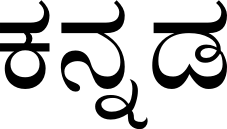Language/Kannada/Grammar/Nouns
| ◀️ Telling Time — Previous Lesson | Next Lesson — Pronouns ▶️ |
Welcome to our lesson on Nouns in Kannada! Nouns are an essential part of any language, serving as the building blocks for communication. They are words used to identify people, places, things, or ideas. Understanding nouns in Kannada is crucial for beginners as they form the basis for constructing sentences and expressing thoughts clearly.
In this lesson, we will explore the following aspects of Kannada nouns:
What are Nouns?[edit | edit source]
Nouns in Kannada, much like in English, can be categorized into different types based on their function and characteristics. Here are the key types of nouns we will discuss:
- Common Nouns: General names for a person, place, or thing.
- Proper Nouns: Specific names of people or places.
- Collective Nouns: Names for a group of things or people.
- Abstract Nouns: Names for ideas or concepts.
Gender of Nouns[edit | edit source]
In Kannada, nouns are classified into three genders: masculine, feminine, and neuter. The gender of a noun affects how it is used in sentences.
- Masculine: Typically refers to male entities.
- Feminine: Generally refers to female entities.
- Neuter: Refers to objects or concepts that are neither male nor female.
Forming Plurals[edit | edit source]
While singular nouns refer to one entity, plural nouns denote two or more. In Kannada, the pluralization of nouns often involves specific suffixes depending on the gender of the noun.
- For masculine nouns, the plural is typically formed by adding -ಗಳೆ (gaLe).
- For feminine nouns, the plural usually ends with -ಗಳು (gaLu).
- Neuter nouns can follow various patterns, often taking the suffix -ಗಳು (gaLu) as well.
Examples of Kannada Nouns[edit | edit source]
Let's illustrate these concepts with some examples:
| Kannada | Pronunciation | English |
|---|---|---|
| ಮನೆ | mane | house |
| ಶಾಲೆ | shāle | school |
| ಕಾಯಿ | kāyi | fruit |
| ಪುಟ್ಟ | puṭṭa | boy |
| ಹುಡುಗಿ | huḍugi | girl |
| ಪುಸ್ತಕ | pustaka | book |
| ಊರು | ūru | village |
| ಹಕ್ಕಿ | hakki | bird |
| ಕಂಬನಿ | kambani | lamp |
| ವಾಹನ | vāhana | vehicle |
Now, let’s see how these nouns change from singular to plural.
| Singular Kannada | Singular Pronunciation | Plural Kannada | Plural Pronunciation | English |
|---|---|---|---|---|
| ಮನೆ | mane | ಮನೆಗಳು | manegaLu | houses |
| ಶಾಲೆ | shāle | ಶಾಲೆಗಳು | shālegaLu | schools |
| ಕಾಯಿ | kāyi | ಕಾಯಿಗಳು | kāyigaLu | fruits |
| ಪುಟ್ಟ | puṭṭa | ಪುಟ್ಟ ಗಳೆ | puṭṭa gaLe | boys |
| ಹುಡುಗಿ | huḍugi | ಹುಡುಗಿಗಳು | huḍugigaLu | girls |
| ಪುಸ್ತಕ | pustaka | ಪುಸ್ತಕಗಳು | pustakaGaLu | books |
| ಊರು | ūru | ಊರುಗಳು | ūruGaLu | villages |
| ಹಕ್ಕಿ | hakki | ಹಕ್ಕಿಗಳು | hakkigaLu | birds |
| ಕಂಬನಿ | kambani | ಕಂಬನಿಗಳು | kambanigaLu | lamps |
| ವಾಹನ | vāhana | ವಾಹನಗಳು | vāhanaGaLu | vehicles |
Practice Exercises[edit | edit source]
Now that we’ve covered the essentials of Kannada nouns, let’s put your understanding to the test with some exercises!
Exercise 1: Identify the Gender[edit | edit source]
Given the following nouns, identify their gender (masculine, feminine, neuter).
1. ಪುಟ್ಟ (puṭṭa)
2. ಹುಡುಗಿ (huḍugi)
3. ಮನೆ (mane)
4. ಪುಸ್ತಕ (pustaka)
5. ಮಕ್ಕಳ (makkaḷa)
Answers:
1. Masculine
2. Feminine
3. Neuter
4. Neuter
5. Masculine
Exercise 2: Singular to Plural Conversion[edit | edit source]
Convert the following singular nouns into plural form.
1. ಹಕ್ಕಿ (hakki)
2. ಶಾಲೆ (shāle)
3. ಮನೆ (mane)
4. ಪುಟ್ಟ (puṭṭa)
5. ಕಾಯಿ (kāyi)
Answers:
1. ಹಕ್ಕಿಗಳು (hakkigaLu)
2. ಶಾಲೆಗಳು (shālegaLu)
3. ಮನೆಗಳು (manegaLu)
4. ಪುಟ್ಟ ಗಳೆ (puṭṭa gaLe)
5. ಕಾಯಿಗಳು (kāyigaLu)
Exercise 3: Fill in the Blanks[edit | edit source]
Fill in the blanks with the correct plural form of the given nouns.
1. ಪುಸ್ತಕ → __________
2. ಹುಡುಗಿ → __________
3. ಕಂಬನಿ → __________
4. ಗಾಡಿ → __________
5. ನದಿ → __________
Answers:
1. ಪುಸ್ತಕಗಳು (pustakaGaLu)
2. ಹುಡುಗಿಗಳು (huḍugigaLu)
3. ಕಂಬನಿಗಳು (kambanigaLu)
4. ಗಾಡಿಗಳು (gāḍigaLu)
5. ನದಿಗಳು (nadigaLu)
Exercise 4: Matching Nouns with Genders[edit | edit source]
Match the Kannada nouns with their correct genders.
1. ಮನೆ
2. ಪುಟ್ಟ
3. ಹಕ್ಕಿ
4. ಕಾಯಿ
5. ಹುಡುಗಿ
Answers:
1. Neuter
2. Masculine
3. Neuter
4. Neuter
5. Feminine
Exercise 5: Create Your Own Sentences[edit | edit source]
Using the nouns from the lesson, create sentences in Kannada. Here's a template to help you:
- ನನಗೆ [Noun] ಇದೆ. (I have [Noun].)
Example Answers:
1. ನನಗೆ ಮನೆ ಇದೆ. (I have a house.)
2. ನನಗೆ ಪುಸ್ತಕ ಇದೆ. (I have a book.)
3. ನನಗೆ ಹಕ್ಕಿ ಇದೆ. (I have a bird.)
Conclusion[edit | edit source]
Understanding nouns in Kannada is a significant step toward mastering the language. By familiarizing yourself with different types of nouns, their genders, and how to form plurals, you can begin to construct meaningful sentences. Remember, practice makes perfect, so keep using these nouns in your daily conversations.
Happy learning, and see you in the next lesson!
Videos[edit | edit source]
Grammar - Concept - Common vs proper nouns (Kannada) - YouTube[edit | edit source]
Sources[edit | edit source]
- Nouns: Naming Words in kannada, part -1,Noun english grammar ...
- Kannada grammar - Wikipedia
- Parts of Speech Part 1 - Noun | Explained in kannada for kids ...
Other Lessons[edit | edit source]
- Adjectives
- Pronouns
- How to Use Be
- Negation
- Future Tense
- Gender
- Give your Opinion
- Questions
- Conditional Mood
| ◀️ Telling Time — Previous Lesson | Next Lesson — Pronouns ▶️ |

